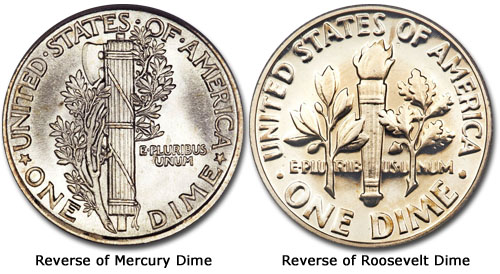MJJ asks: Please explain the image that appears on the back (tails side) of an ordinary dime. It’s driving me crazy. What are the plants/flowers? why are they there? what is the significance of the torch? Thanks.
The Roosevelt dime’s reverse was an evolution of the Winged Liberty Cap dime (commonly called the Mercury dime). The Mercury dime design was created just before the United State’s entry into WW I. The reverse design shows the Roman fasces which consists of an executioner’s axe bound to a bundle or rods or sticks. The symbol represented the power of life or death and was a strong, belligerent statement very much like “Don’t tread on me” or “Beware enemies of Liberty”.
In Ancient Roman times it represented the power to kill mercifully by the axe or slowly and painfully by the rods. Unfortunately, the faces symbol also became the symbol of the Italian Fascists, the Blackshirts, in the 1920’s. Americans seemed to have missed this association and the Mercury dime stayed unchanged until 1945.
When President Franklin D. Roosevelt passed away, he was commemorated on the dime and his bust replaced the Winged Liberty motif. It was also an opportunity to eliminate the faces in favor of a Liberty Torch with the bundle of rods making up the base. The vegetation is an olive branch representing peace.
